内标法及外标法方法、原理、优缺点
[讨论]内标法与外标法的应用
![[讨论]内标法与外标法的应用](https://img.taocdn.com/s3/m/4238a780f18583d0496459a5.png)
[讨论]内标法与外标法的应用内标法:选择适当的物质作为内标物质,定量加入被测样品中,跟据被测组分和内标物质的峰面积之比,乘以校正因子,对映内标物质加入量所进行含量测定方法。
内标法的优点:色谱条件对结果影响不大,准确度、精度较高;缺点:选择合适的内标物质比教困难。
外标法:又称标准曲线法,依照测量标准品所绘制的曲线来计量被测样品的含量的方法。
外标法的优点:简单,适和大量样品分析。
缺点:每次色谱条件很难相同,容易出现误差。
请问大家在做含量测定时依照什么原则来选定方法的?我们一般作体外药物分析时均采用外标法,体内药物分析,因提取步骤烦琐,都采用内标法进行校正,但如果仪器稳定、方法的重现性好,也可使用外标法,国外体内药物分析用外标法的也有不少,但本人认为最好使用内标法。
实际样品检测用外标法的更多。
原因:1.内标物难获得,特别是同位素标记的有相近行为的内标物;2.操作步骤多、计算烦琐如在新药报批中使用内标物,则需报送内标物的结构确证资料,在报生产的同时还要报送此内标物对照品。
所以现在连SDA的专家都不推荐使用内标法。
最初使用内标是因为进样器进样不准确,采用内标可以校正进样误差。
现在的HPLC用定量环进样准确度很高,加了内标有时候因为操作的误差反而降低准确度。
在药物质量检验中,如果是原料药,或者制剂的成份不很多,用外标法即可,不一定非要用内标法,而且现在越来越多的标准都放弃了用内标法。
对于体内药物分析,分析方法的误差反而不是那么的重要,而在样品处理的过程中引入的误差要引起足够的重视,所以,一般在处理过程中加入内标以校正误差。
这个时候,回收率的高低又不是绝对的要求很高,虽然要求绝对回收率在70%或者80%以上,但是,有时候低一些也无所谓,关键是回收率的稳定性,测定的重现性。
欢迎行家指点:)--------------------------------------------------------------------------------却是如此,我刚刚做完体内药物分析,内标法却是比较麻烦--------------------------------------------------------------------------------个人认为体内分析应该用内标法,否则结果不准确。
试简述内标法外标法和标准曲线法的区别与联系
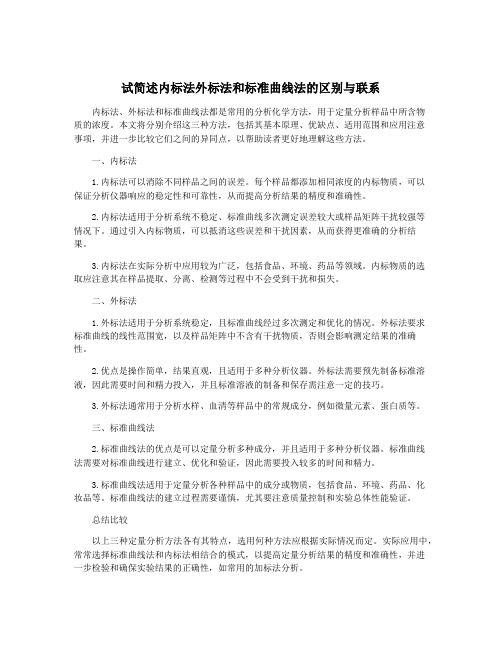
试简述内标法外标法和标准曲线法的区别与联系内标法、外标法和标准曲线法都是常用的分析化学方法,用于定量分析样品中所含物质的浓度。
本文将分别介绍这三种方法,包括其基本原理、优缺点、适用范围和应用注意事项,并进一步比较它们之间的异同点,以帮助读者更好地理解这些方法。
一、内标法1.内标法可以消除不同样品之间的误差。
每个样品都添加相同浓度的内标物质,可以保证分析仪器响应的稳定性和可靠性,从而提高分析结果的精度和准确性。
2.内标法适用于分析系统不稳定、标准曲线多次测定误差较大或样品矩阵干扰较强等情况下。
通过引入内标物质,可以抵消这些误差和干扰因素,从而获得更准确的分析结果。
3.内标法在实际分析中应用较为广泛,包括食品、环境、药品等领域。
内标物质的选取应注意其在样品提取、分离、检测等过程中不会受到干扰和损失。
二、外标法1.外标法适用于分析系统稳定,且标准曲线经过多次测定和优化的情况。
外标法要求标准曲线的线性范围宽,以及样品矩阵中不含有干扰物质,否则会影响测定结果的准确性。
2.优点是操作简单,结果直观,且适用于多种分析仪器。
外标法需要预先制备标准溶液,因此需要时间和精力投入,并且标准溶液的制备和保存需注意一定的技巧。
3.外标法通常用于分析水样、血清等样品中的常规成分,例如微量元素、蛋白质等。
三、标准曲线法2.标准曲线法的优点是可以定量分析多种成分,并且适用于多种分析仪器。
标准曲线法需要对标准曲线进行建立、优化和验证,因此需要投入较多的时间和精力。
3.标准曲线法适用于定量分析各种样品中的成分或物质,包括食品、环境、药品、化妆品等。
标准曲线法的建立过程需要谨慎,尤其要注意质量控制和实验总体性能验证。
总结比较以上三种定量分析方法各有其特点,选用何种方法应根据实际情况而定。
实际应用中,常常选择标准曲线法和内标法相结合的模式,以提高定量分析结果的精度和准确性,并进一步检验和确保实验结果的正确性,如常用的加标法分析。
标准曲线法和外标法均应为线性关系,对于标准曲线法,通常需要至少5个或以上的标准浓度级别和与之相对应的响应信号结果,将数据进行回归拟合,从而建立标准曲线方程,并验证其可靠性和准确性。
液相色谱判断内标外标的简答题
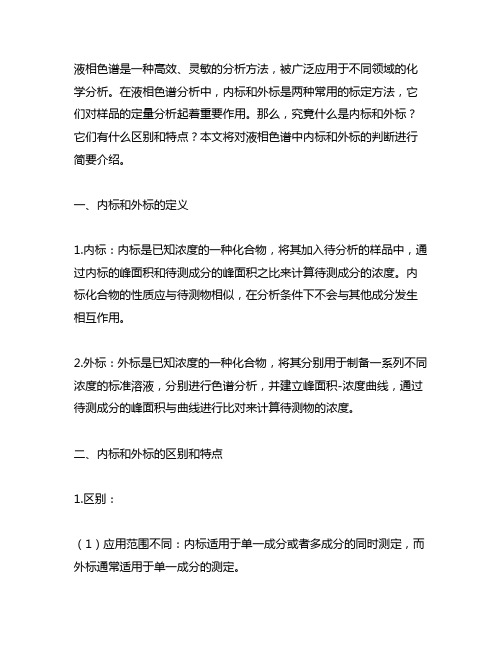
液相色谱是一种高效、灵敏的分析方法,被广泛应用于不同领域的化学分析。
在液相色谱分析中,内标和外标是两种常用的标定方法,它们对样品的定量分析起着重要作用。
那么,究竟什么是内标和外标?它们有什么区别和特点?本文将对液相色谱中内标和外标的判断进行简要介绍。
一、内标和外标的定义1.内标:内标是已知浓度的一种化合物,将其加入待分析的样品中,通过内标的峰面积和待测成分的峰面积之比来计算待测成分的浓度。
内标化合物的性质应与待测物相似,在分析条件下不会与其他成分发生相互作用。
2.外标:外标是已知浓度的一种化合物,将其分别用于制备一系列不同浓度的标准溶液,分别进行色谱分析,并建立峰面积-浓度曲线,通过待测成分的峰面积与曲线进行比对来计算待测物的浓度。
二、内标和外标的区别和特点1.区别:(1)应用范围不同:内标适用于单一成分或者多成分的同时测定,而外标通常适用于单一成分的测定。
(2)计算方式不同:内标的计算方式是比对内标和待测成分的峰面积比值,而外标是通过峰面积-浓度曲线进行计算。
(3)数据处理方式不同:内标的数据处理相对简便,外标需要建立标准曲线,并对数据进行外标法计算。
2.特点:(1)内标法的灵敏度高,适用于成分浓度较低的样品的分析。
(2)外标法准确性高,适用于不同浓度范围内待测物的分析。
三、如何判断使用内标还是外标1.成分复杂度:对于成分比较单一的样品,可以考虑使用外标法,而多成分的样品则更适合使用内标法进行分析。
2.成分浓度范围:如果待测成分的浓度范围较大,外标法的线性范围能满足分析要求,则可以选择外标法;如果待测成分浓度较低,内标法更为适用。
3.分析要求:如果对分析数据的灵敏度要求较高,可以考虑采用内标法;如果对分析数据的准确性要求较高,可以选择外标法。
内标和外标是液相色谱分析中常用的标定方法,其区别和特点决定了它们的适用范围和应用场景。
在选择使用内标还是外标时,需要综合考虑待测样品的成分复杂度、浓度范围以及分析要求等因素,以确保分析结果的准确性和可靠性。
[讨论]内标法与外标法的应用
![[讨论]内标法与外标法的应用](https://img.taocdn.com/s3/m/71c318f4f5335a8103d2207b.png)
[讨论]内标法与外标法的应用内标法:选择适当的物质作为内标物质,定量加入被测样品中,跟据被测组分和内标物质的峰面积之比,乘以校正因子,对映内标物质加入量所进行含量测定方法。
内标法的优点:色谱条件对结果影响不大,准确度、精度较高;缺点:选择合适的内标物质比教困难。
外标法:又称标准曲线法,依照测量标准品所绘制的曲线来计量被测样品的含量的方法。
外标法的优点:简单,适和大量样品分析。
缺点:每次色谱条件很难相同,容易出现误差。
请问大家在做含量测定时依照什么原则来选定方法的?我们一般作体外药物分析时均采用外标法,体内药物分析,因提取步骤烦琐,都采用内标法进行校正,但如果仪器稳定、方法的重现性好,也可使用外标法,国外体内药物分析用外标法的也有不少,但本人认为最好使用内标法。
实际样品检测用外标法的更多。
原因:1.内标物难获得,特别是同位素标记的有相近行为的内标物;2.操作步骤多、计算烦琐如在新药报批中使用内标物,则需报送内标物的结构确证资料,在报生产的同时还要报送此内标物对照品。
所以现在连SDA的专家都不推荐使用内标法。
最初使用内标是因为进样器进样不准确,采用内标可以校正进样误差。
现在的HPLC用定量环进样准确度很高,加了内标有时候因为操作的误差反而降低准确度。
在药物质量检验中,如果是原料药,或者制剂的成份不很多,用外标法即可,不一定非要用内标法,而且现在越来越多的标准都放弃了用内标法。
对于体内药物分析,分析方法的误差反而不是那么的重要,而在样品处理的过程中引入的误差要引起足够的重视,所以,一般在处理过程中加入内标以校正误差。
这个时候,回收率的高低又不是绝对的要求很高,虽然要求绝对回收率在70%或者80%以上,但是,有时候低一些也无所谓,关键是回收率的稳定性,测定的重现性。
欢迎行家指点:)--------------------------------------------------------------------------------却是如此,我刚刚做完体内药物分析,内标法却是比较麻烦--------------------------------------------------------------------------------个人认为体内分析应该用内标法,否则结果不准确。
内标法及外标法方法、原理、优缺点
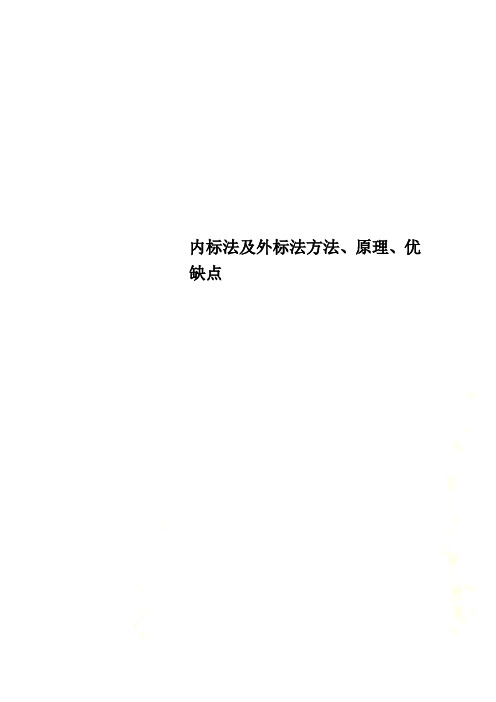
内标法及外标法方法、原理、优缺点of the most important characteristics of an internal standard is that itco-elutes with the compound to be quantified.How do I use an internal standard?First of all an internal standard should be added at the beginning of the sample work-up, typically before the plasma crash or solid phase extraction. The internal standard should be added at the same level in every sample including the standards. An internal standard should give a reliable MS response. Care should be taken that the amount of the internal standard is well above the limit of quantitation but not so high as to suppress the ionization of the analyte. "How much internal standard should I add?", this is an important question. It pays to know roughly how much compound is in your sample. This can be accomplished by making trial analyses of an early, middle and late time point with perhaps one or two standard points. This information will be very valuable when building an appropriate standard curve and in knowing how much internal standard to add. If you were trying to quantify samples in the range of 100 fg to 25 pg and the limit of detection was 100 fg you might add 5 to 10 pg of internal standard to every sample. A good rule of thumb is to target the internal standard to the lower 1/3 of the working standard curve. This is a range that will give a comfortable response without interfering with the ionization of the analyte.--------------------------------------------------------------------------------中文:什么叫内标法?怎样选择内标物?内标法是一种间接或相对的校准方法。
色谱分析中归一化法、外标法、内标法的区别,十六变卦法
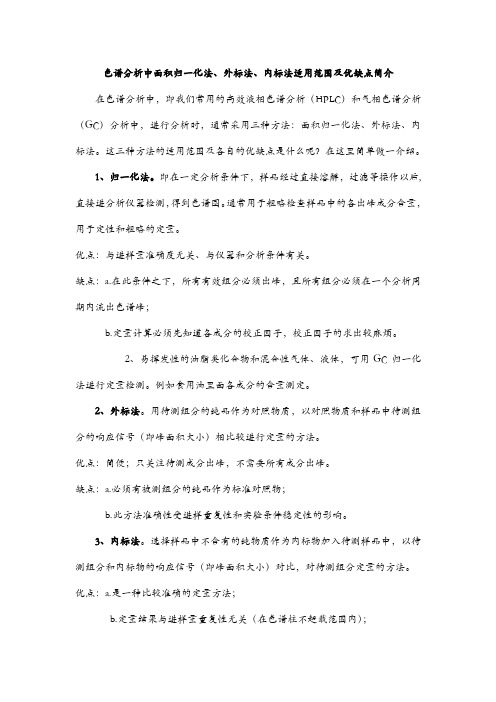
色谱分析中面积归一化法、外标法、内标法适用范围及优缺点简介在色谱分析中,即我们常用的高效液相色谱分析(HPLC)和气相色谱分析(GC)分析中,进行分析时,通常采用三种方法:面积归一化法、外标法、内标法。
这三种方法的适用范围及各自的优缺点是什么呢?在这里简单做一介绍。
1、归一化法。
即在一定分析条件下,样品经过直接溶解,过滤等操作以后,直接进分析仪器检测,得到色谱图。
通常用于粗略检查样品中的各出峰成分含量,用于定性和粗略的定量。
优点:与进样量准确度无关、与仪器和分析条件有关。
缺点:a.在此条件之下,所有有效组分必须出峰,且所有组分必须在一个分析周期内流出色谱峰;b.定量计算必须先知道各成分的校正因子,校正因子的求出较麻烦。
2、易挥发性的油脂类化合物和混合性气体、液体,可用GC归一化法进行定量检测。
例如食用油里面各成分的含量测定。
2、外标法。
用待测组分的纯品作为对照物质,以对照物质和样品中待测组分的响应信号(即峰面积大小)相比较进行定量的方法。
优点:简便;只关注待测成分出峰,不需要所有成分出峰。
缺点:a.必须有被测组分的纯品作为标准对照物;b.此方法准确性受进样重复性和实验条件稳定性的影响。
3、内标法。
选择样品中不含有的纯物质作为内标物加入待测样品中,以待测组分和内标物的响应信号(即峰面积大小)对比,对待测组分定量的方法。
优点:a.是一种比较准确的定量方法;b.定量结果与进样量重复性无关(在色谱柱不超载范围内);c.只需要内标物与被测物出峰,达到一定的分离度即可;d.常用于样品的GC定量检测以及微量成分含量检测;缺点:配置较麻烦;内标物需要跟待测组分在同样条件下出峰,且分离度较好,所以选择合适的内标物比较困难。
十六变卦法十六变卦由先天八卦与后天洛书配合而成八宫次序,而每一宫又按照十二消息往返变化,是最为完备的阴阳卦气流变方法。
其前后左右一共交荡了四回,符合天四变、地四变,人四变、鬼四变的四四十六变卦规则,实是理论至宝,然而明白此理者少之又少,实为遗憾。
外标法与内标法的区别

内标法:是一种间接或相对的校准方法。
在分析测定样品中某组分含量时,加入一种内标物质以校谁和消除出于操作条件的波动而对分析结果产生的影响,以提高分析结果的准确度。
内标法在气相色谱定量分析中是一种重要的技术。
使用内标法时,在样品中加入一定量的标准物质,它可被色谱拄所分离,又不受试样中其它组分峰的干扰,只要测定内标物和待测组分的峰面积与相对响应值,即可求出待测组分在样品中的百分含量。
外标法:用待测组分的纯品作对照物质,以对照物质和样品中待测组分的响应信号相比较进行定量的方法称为外标法。
此法可分为工作曲线法及外标一点法等。
工作曲线法是用对照物质配制一系列浓度的对照品溶液确定工作曲线,求出斜率、截距。
在完全相同的条件下,准确进样与对照品溶液相同体积的样品溶液,根据待测组分的信号,从标准曲线上查出其浓度,或用回归方程计算,工作曲线法也可以用外标二点法代替。
通常截距应为零,若不等于零说明存在系统误差。
工作曲线的截距为零时,可用外标一点法(直接比较法)定量。
外标一点法是用一种浓度的对照品溶液对比测定样品溶液中i组分的含量。
将对照品溶液与样品溶液在相同条件下多次进样,测得峰面积的平均值,用下式计算样品中i组分的量:W=A(W)/(A)式中W与A分别代表在样品溶液进样体积中所含i组分的重量及相应的峰面积。
(W)及(A)分别代表在对照品溶液进样体积中含纯品i组分的重量及相应峰面积。
外标法方法简便,不需用校正因子,不论样品中其他组分是否出峰,均可对待测组分定量。
但此法的准确性受进样重复性和实验条件稳定性的影响。
此外,为了降低外标一点法的实验误差,应尽量使配制的对照品溶液的浓度与样品中组分的浓度相近。
外标法external standard method色谱分析中的一种定量方法,它不是把标准物质加入到被测样品中,而是在与被测样品相同的色谱条件下单独测定,把得到的色谱峰面积与被测组分的色谱峰面积进行比较求得被测组分的含量。
色谱分析中归一化法、外标法、内标法的区别

色谱分析中面积归一化法、外标法、内标法适用范围及优缺点简介(一)在色谱分析中,即我们常用的高效液相色谱分析(HPLC)和气相色谱分析(GC)分析中,进行分析时,通常采用三种方法:面积归一化法、外标法、内标法。
这三种方法的适用范围及各自的优缺点是什么呢?在这里简单做一介绍。
1、归一化法。
即在一定分析条件下,样品经过直接溶解,过滤等操作以后,直接进分析仪器检测,得到色谱图。
通常用于粗略检查样品中的各出峰成分含量,用于定性和粗略的定量。
优点:与进样量准确度无关、与仪器和分析条件有关。
缺点:a.在此条件之下,所有有效组分必须出峰,且所有组分必须在一个分析周期内流出色谱峰;b.定量计算必须先知道各成分的校正因子,校正因子的求出较麻烦。
2、易挥发性的油脂类化合物和混合性气体、液体,可用GC 归一化法进行定量检测。
例如食用油里面各成分的含量测定。
2、外标法。
用待测组分的纯品作为对照物质,以对照物质和样品中待测组分的响应信号(即峰面积大小)相比较进行定量的方法。
优点:简便;只关注待测成分出峰,不需要所有成分出峰。
缺点:a.必须有被测组分的纯品作为对照物;b.此方法准确性受进样重复性和实验条件稳定性的影响。
3、内标法。
选择样品中不含有的纯物质作为内标物加入待测样品中,以待测组分和内标物的响应信号(即峰面积大小)对比,对待测组分定量的方法。
优点:a.是一种比较准确的定量方法;b.定量结果与进样量重复性无关(在色谱柱不超载范围内);c.只需要内标物与被测物出峰,达到一定的分离度即可;d.常用于样品的GC定量检测以及微量成分含量检测;缺点:配置较麻烦;内标物需要跟待测组分在同样条件下出峰,且分离度较好,所以选择合适的内标物比较困难。
液质联用外标法和内标法

液质联用外标法和内标法
液质联用技术是一种高效的分析方法,广泛应用于生物、医药、环
境等领域。
在液质联用技术中,外标法和内标法是常用的两种定量方法。
本文将从原理、优缺点、应用等方面介绍液质联用外标法和内标法。
一、外标法
外标法是指在样品中加入已知浓度的标准物质,通过比较标准物质和
样品中目标物质的响应值,计算出目标物质的浓度。
外标法的优点是
简单易行,适用于大多数分析物。
但是,外标法的缺点是受到样品制备、仪器响应等因素的影响,容易产生误差。
二、内标法
内标法是指在样品中加入已知浓度的内标物质,通过比较内标物质和
目标物质的响应值,计算出目标物质的浓度。
内标法的优点是可以消
除样品制备、仪器响应等因素的影响,提高分析结果的准确性。
但是,内标法需要选择合适的内标物质,且内标物质的浓度应与目标物质的
浓度相近,否则会影响分析结果。
三、应用
液质联用外标法和内标法在生物、医药、环境等领域都有广泛的应用。
例如,在药物代谢动力学研究中,可以使用外标法和内标法测定药物
在体内的浓度变化;在环境监测中,可以使用外标法和内标法测定水
中有机污染物的浓度等。
总之,液质联用外标法和内标法是常用的定量方法,各有优缺点,应
根据实际情况选择合适的方法。
在实际应用中,还需要注意样品制备、仪器响应等因素对分析结果的影响,以提高分析结果的准确性。
内标法及外标法方法原理优缺点
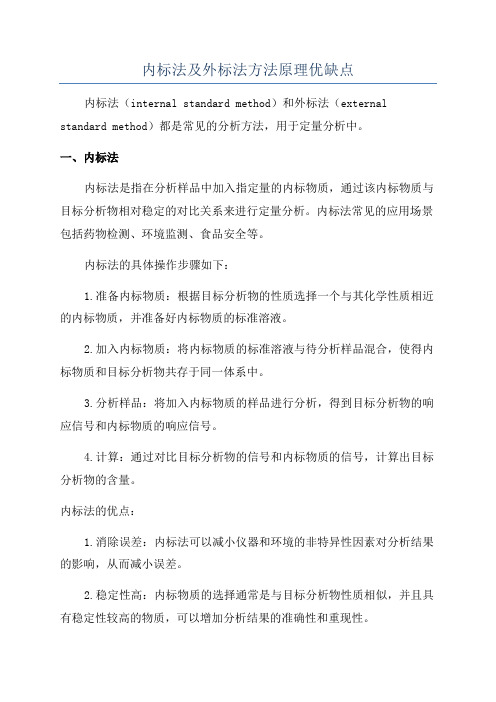
内标法及外标法方法原理优缺点内标法(internal standard method)和外标法(external standard method)都是常见的分析方法,用于定量分析中。
一、内标法内标法是指在分析样品中加入指定量的内标物质,通过该内标物质与目标分析物相对稳定的对比关系来进行定量分析。
内标法常见的应用场景包括药物检测、环境监测、食品安全等。
内标法的具体操作步骤如下:1.准备内标物质:根据目标分析物的性质选择一个与其化学性质相近的内标物质,并准备好内标物质的标准溶液。
2.加入内标物质:将内标物质的标准溶液与待分析样品混合,使得内标物质和目标分析物共存于同一体系中。
3.分析样品:将加入内标物质的样品进行分析,得到目标分析物的响应信号和内标物质的响应信号。
4.计算:通过对比目标分析物的信号和内标物质的信号,计算出目标分析物的含量。
内标法的优点:1.消除误差:内标法可以减小仪器和环境的非特异性因素对分析结果的影响,从而减小误差。
2.稳定性高:内标物质的选择通常是与目标分析物性质相似,并且具有稳定性较高的物质,可以增加分析结果的准确性和重现性。
3.方便快捷:内标法的操作相对简单,适用于高通量的样品分析。
内标法的缺点1.内标物质的选择:选择合适的内标物质需要对目标分析物的化学性质有一定的了解,有时可能会遇到难以找到合适的内标物质的情况。
2.干扰因素:如果样品中存在与内标物质相似的物质或者存在与目标分析物相互作用的物质,可能会干扰分析结果。
二、外标法外标法是指将待测样品与已知浓度、纯度的外部参考物质进行比对,通过浓度差异来进行定量分析。
外标法常见的应用场景包括药物分析、生物学研究等。
外标法的具体操作步骤如下:1.准备外标物质:选择一个与目标分析物具有相似物理化学性质的外标物质,并准备好外标物质的标准溶液。
2.建立标准曲线:根据外标物质的标准溶液的不同浓度,分别测量其响应信号,并绘制标准曲线。
3.测量样品:将样品进行测量,得到目标分析物的响应信号。
色 谱 定 量 方 法___归一化法、外标法、内标法的区别

色谱定量方法一、归一化法由于组分的量与其峰面积成正比,如果样品中所有组分都能产生信号,得到相应的色谱峰,那么可以用如下归一化公式计算各组分的含量。
(7.34)若样品中各组分的校正因子相近,可将校正因子消去,直接用峰面积归一化进行计算。
中国药典用不加校正因子的面积归一化法测定药物中各杂质及杂质的总量限度。
(7.35)归一化法的优点是:简便、准确、定量结果与进样量重复性无关(在色谱柱不超载的范围内)、操作条件略有变化时对结果影响较小。
缺点是:必须所有组分在一个分析周期内都流出色谱柱,而且检测器对它们都产生信号。
不适于微量杂质的含量测定。
二、外标法用待测组分的纯品作对照物质,以对照物质和样品中待测组分的响应信号相比较进行定量的方法称为外标法。
此法可分为工作曲线法及外标一点法等。
工作曲线法是用对照物质配制一系列浓度的对照品溶液确定工作曲线,求出斜率、截距。
在完全相同的条件下,准确进样与对照品溶液相同体积的样品溶液,根据待测组分的信号,从标准曲线上查出其浓度,或用回归方程计算,工作曲线法也可以用外标二点法代替。
通常截距应为零,若不等于零说明存在系统误差。
工作曲线的截距为零时,可用外标一点法(直接比较法)定量。
外标一点法是用一种浓度的对照品溶液对比测定样品溶液中i组分的含量。
将对照品溶液与样品溶液在相同条件下多次进样,测得峰面积的平均值,用下式计算样品中i组分的量:W=A(W)/(A)(7.36)式中W与A分别代表在样品溶液进样体积中所含i组分的重量及相应的峰面积。
(W)及(A)分别代表在对照品溶液进样体积中含纯品i组分的重量及相应峰面积。
外标法方法简便,不需用校正因子,不论样品中其他组分是否出峰,均可对待测组分定量。
但此法的准确性受进样重复性和实验条件稳定性的影响。
此外,为了降低外标一点法的实验误差,应尽量使配制的对照品溶液的浓度与样品中组分的浓度相近。
三、内标法选择样品中不含有的纯物质作为对照物质加入待测样品溶液中,以待测组分和对照物质的响应信号对比,测定待测组分含量的方法称为内标法。
内标法外标法的原理
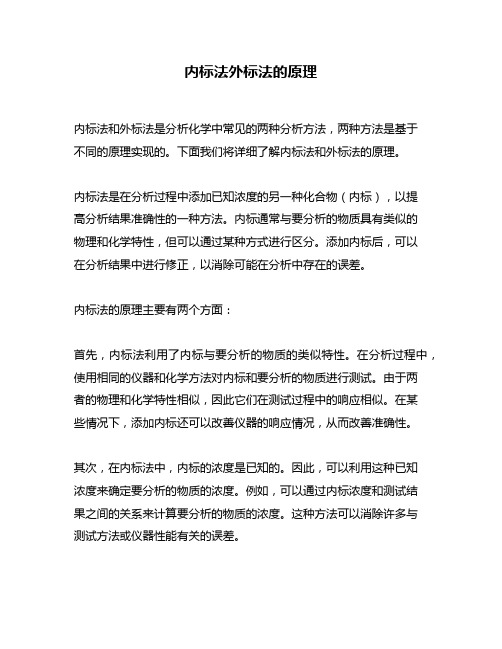
内标法外标法的原理内标法和外标法是分析化学中常见的两种分析方法,两种方法是基于不同的原理实现的。
下面我们将详细了解内标法和外标法的原理。
内标法是在分析过程中添加已知浓度的另一种化合物(内标),以提高分析结果准确性的一种方法。
内标通常与要分析的物质具有类似的物理和化学特性,但可以通过某种方式进行区分。
添加内标后,可以在分析结果中进行修正,以消除可能在分析中存在的误差。
内标法的原理主要有两个方面:首先,内标法利用了内标与要分析的物质的类似特性。
在分析过程中,使用相同的仪器和化学方法对内标和要分析的物质进行测试。
由于两者的物理和化学特性相似,因此它们在测试过程中的响应相似。
在某些情况下,添加内标还可以改善仪器的响应情况,从而改善准确性。
其次,在内标法中,内标的浓度是已知的。
因此,可以利用这种已知浓度来确定要分析的物质的浓度。
例如,可以通过内标浓度和测试结果之间的关系来计算要分析的物质的浓度。
这种方法可以消除许多与测试方法或仪器性能有关的误差。
外标法是一种常见的定量分析方法,其中通过标准曲线(外标)来确定未知物质的浓度。
在外标法中,先制备一系列已知浓度的标准,然后对每个标准进行测试,并绘制标准曲线。
曲线通常是一条直线,其中标准的浓度与测试结果呈正比例关系。
然后,通过测量未知样品的响应,并在标准曲线上查找相应的浓度,就可以计算未知物质的浓度。
外标法的原理也有以下两个方面:首先,外标法利用了标准曲线的线性响应。
在某些情况下,测试结果与标准物质的浓度呈线性关系。
因此,绘制标准曲线可以有效地计算未知物质的浓度。
其次,在外标法中,已知物质的浓度是已知的。
因此,可以利用这种已知浓度来确定未知物质的浓度。
例如,可以通过对标准曲线上相应点的插值和外推来计算未知物质的浓度。
这种方法可以消除通常与测试方法或仪器性能有关的误差。
总之,内标法和外标法都是分析化学中常见的分析方法。
内标法是在分析过程中添加已知浓度的另一种化合物(内标),以提高分析结果准确性的一种方法。
四种定量方法介绍及优缺点对比
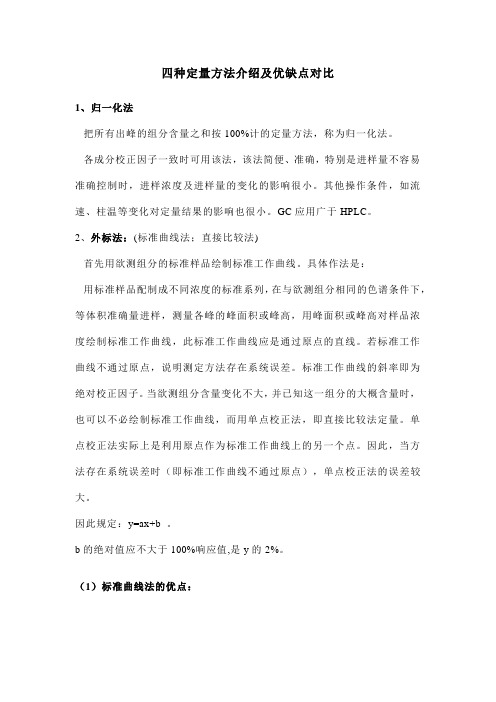
四种定量方法介绍及优缺点对比1、归一化法把所有出峰的组分含量之和按100%计的定量方法,称为归一化法。
各成分校正因子一致时可用该法,该法简便、准确,特别是进样量不容易准确控制时,进样浓度及进样量的变化的影响很小。
其他操作条件,如流速、柱温等变化对定量结果的影响也很小。
GC应用广于HPLC。
2、外标法:(标准曲线法;直接比较法)首先用欲测组分的标准样品绘制标准工作曲线。
具体作法是:用标准样品配制成不同浓度的标准系列,在与欲测组分相同的色谱条件下,等体积准确量进样,测量各峰的峰面积或峰高,用峰面积或峰高对样品浓度绘制标准工作曲线,此标准工作曲线应是通过原点的直线。
若标准工作曲线不通过原点,说明测定方法存在系统误差。
标准工作曲线的斜率即为绝对校正因子。
当欲测组分含量变化不大,并已知这一组分的大概含量时,也可以不必绘制标准工作曲线,而用单点校正法,即直接比较法定量。
单点校正法实际上是利用原点作为标准工作曲线上的另一个点。
因此,当方法存在系统误差时(即标准工作曲线不通过原点),单点校正法的误差较大。
因此规定:y=ax+b 。
b的绝对值应不大于100%响应值,是y的2%。
(1)标准曲线法的优点:绘制好标准工作曲线后测定工作就很简单了,计算时可直接从标准工作曲线上读出含量,这对大量样品分析十分合适。
特别是标准工作曲线绘制后可以使用一段时间,在此段时间内可经常用一个标准样品对标准工作曲线进行单点校正,以确定该标准工作曲线是否还可使用。
(2)标准曲线法的缺点:每次样品分析的色谱条件(检测器的响应性能,柱温度,流动相流速及组成,进样量,柱效等)很难完全相同,因此容易出现较大误差。
另外标准工作曲线绘制时,一般使用欲测组分的标准样品(或已知准确含量的样品),因此对样品前处理过程中欲测组分的变化无法进行补偿。
3、内标法:选择适宜的物质作为欲测组分的参比物,定量加到样品中去,依据欲测组分和参比物在检测器上的响应值(峰面积或峰高)之比和参比物加入的量进行定量分析的方法称为内标法。
色谱分析中归一化法、外标法、内标法的区别

色谱分析中面积归一化法、外标法、内标法适用范围及优缺点简介在色谱分析中,即我们常用的高效液相色谱分析(HPLC)和气相色谱分析(GC)分析中,进行分析时,通常采用三种方法:面积归一化法、外标法、内标法.这三种方法的适用范围及各自的优缺点是什么呢?在这里简单做一介绍。
1、归一化法.即在一定分析条件下,样品经过直接溶解,过滤等操作以后,直接进分析仪器检测,得到色谱图。
通常用于粗略检查样品中的各出峰成分含量,用于定性和粗略的定量。
优点:与进样量准确度无关、与仪器和分析条件有关。
缺点:a。
在此条件之下,所有有效组分必须出峰,且所有组分必须在一个分析周期内流出色谱峰;b.定量计算必须先知道各成分的校正因子,校正因子的求出较麻烦。
2、易挥发性的油脂类化合物和混合性气体、液体,可用GC归一化法进行定量检测.例如食用油里面各成分的含量测定。
2、外标法.用待测组分的纯品作为对照物质,以对照物质和样品中待测组分的响应信号(即峰面积大小)相比较进行定量的方法。
优点:简便;只关注待测成分出峰,不需要所有成分出峰.缺点:a.必须有被测组分的纯品作为标准对照物;b.此方法准确性受进样重复性和实验条件稳定性的影响。
3、内标法。
选择样品中不含有的纯物质作为内标物加入待测样品中,以待测组分和内标物的响应信号(即峰面积大小)对比,对待测组分定量的方法。
优点:a。
是一种比较准确的定量方法;b。
定量结果与进样量重复性无关(在色谱柱不超载范围内);c.只需要内标物与被测物出峰,达到一定的分离度即可;d。
常用于样品的GC定量检测以及微量成分含量检测;缺点:配置较麻烦;内标物需要跟待测组分在同样条件下出峰,且分离度较好,所以选择合适的内标物比较困难。
色谱定量计算三种方法,归一化法,内标法和外标法

色谱法是根据色谱峰的面积或高度进行定量分析的。
色谱定量计算方法很多,目前比较广泛应用的有归一化法、内标法和外标法。
1. 归一化法如果试样中所有组分均能流出色谱柱并显示色谱峰,则可用此法计算组分含量。
设试样中共有n个组分,各组分的量分别为m1,m2,……,m n,则i种组分的百分含量为:归一化法的优点是简便、准确,进样量的多少不影响定量的准确性,操作条件的变动对结果的影响也较小,对组分的同时测定尤其显得方便。
缺点是试样中所用的组分必须全部出峰,某些不需定量的组分也需测出其校正因子和峰面积,因此应用受到一些限制。
2. 内标法当试样中所有组分不能全部出峰,或只要求测定试样中某个或几个组分时,可用此法。
准确称取m(g)试样,加入某种纯物质ms(g)作为内标物,根据试样和内标物的质量比m s/m及相应的色谱峰面积之比,基于下式可求组分i的百分含量W i%:因为所以内标物的选择条件是:内标物与试样互溶且是试样中不存在的纯物质;内标物的色谱峰既处于待测组分峰附近,彼此又能很好地分开且不受其它峰干扰;加入量宜与待测组分量相近。
内标法的优点是定量准确,操作条件不必严格控制,且不象归一化法那样在使用上有所限制。
缺点是必须对试样和内标物准确称重,比较费时。
3. 外标法(亦称标准曲线法)该法是在一定色谱操作条件下,用纯物质配制一系列不同的浓度的标准样,定量进样,按测得的峰面积对标准系列的浓度作图绘制标准曲线。
进行试样分析时,在与标准系列严格相同的条件下定量进样,由所得峰面积从标准曲线上即可查得待测组分的含量。
外标法的优点是操作和计算简便,不需要知道所有组分的相对校正因子,其准确度主要取决于进样量的准确和重现性,以及操作条件的稳定性。
内标法及外标法方法原理优缺点
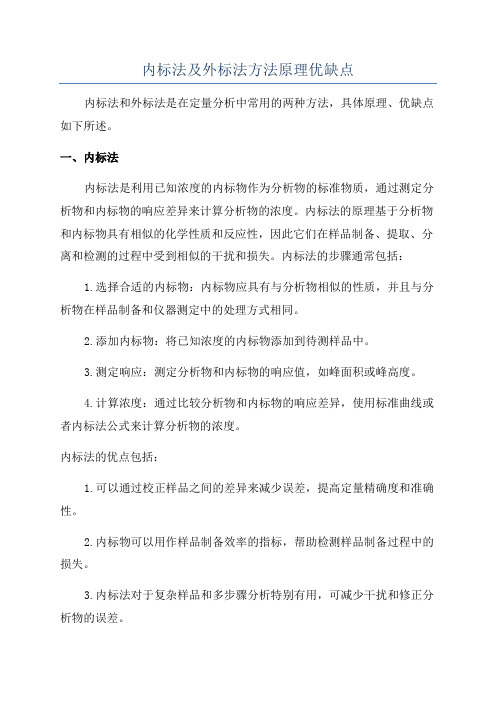
内标法及外标法方法原理优缺点内标法和外标法是在定量分析中常用的两种方法,具体原理、优缺点如下所述。
一、内标法内标法是利用已知浓度的内标物作为分析物的标准物质,通过测定分析物和内标物的响应差异来计算分析物的浓度。
内标法的原理基于分析物和内标物具有相似的化学性质和反应性,因此它们在样品制备、提取、分离和检测的过程中受到相似的干扰和损失。
内标法的步骤通常包括:1.选择合适的内标物:内标物应具有与分析物相似的性质,并且与分析物在样品制备和仪器测定中的处理方式相同。
2.添加内标物:将已知浓度的内标物添加到待测样品中。
3.测定响应:测定分析物和内标物的响应值,如峰面积或峰高度。
4.计算浓度:通过比较分析物和内标物的响应差异,使用标准曲线或者内标法公式来计算分析物的浓度。
内标法的优点包括:1.可以通过校正样品之间的差异来减少误差,提高定量精确度和准确性。
2.内标物可以用作样品制备效率的指标,帮助检测样品制备过程中的损失。
3.内标法对于复杂样品和多步骤分析特别有用,可减少干扰和修正分析物的误差。
4.可以使用相对较简单的标准曲线法或内标法公式,无需复杂的校正计算。
内标法的缺点包括:1.需要选择合适的内标物,其化学性质和反应性应与分析物尽可能相似。
2.内标物添加的量需要准确,过多或过少都会对测定结果产生影响。
3.内标物和分析物之间的动态响应差异可能导致一定的误差,尤其是在非线性范围内。
4.内标法的准确性和精确度严重依赖于仪器的精确度和重复性,以及样品制备和测定过程的一致性。
二、外标法外标法是将一系列已知浓度的标准物质直接与待测样品进行比较,由此推导出待测物质的浓度。
外标法的原理是测定待测物质和标准物质的响应差异,通过标准曲线或者比对法来计算待测物质的浓度。
外标法的步骤通常包括:1.准备标准曲线:制备一系列已知浓度的标准溶液,并测定其响应值,如峰面积或峰高度。
2.测定待测样品:将待测样品进行相同的分析条件下的测定,测定其响应值。
色谱定量分析方法可以分为外标法

色谱定量分析方法可以分为外标法、内标法、归一化法三大类。
当能够精确进样量的时候,通常采用外标法进行定量。
这种方法标准物质单独进样分析,从而确定待测组分的校正因子;实际样品进样分析后依据此校正因子对待测组分色谱峰进行计算得出含量。
其特点是标准物质和未知样品分开进样,虽然看上去是二次进样,但实际上未知样品只需要一次进样分析就能得到结果。
外标法的优点是操作简单,不需要前处理。
缺点是要求精确进样,进样量的差异直接导致分析误差的产生。
外标法是最常用的定量方法,其计算过程如下:1.绝对校正因子gi的计算gi=ms/Ai式中ms是标准样品中组分i的含量,Ai是标准样品谱图中组分i的峰面积。
2.外标法的计算公式mi=Ai * gi这里mi是未知样品中组分i的含量。
(相对校正因子是某组分的绝对校正因子与标准物质绝对校正因子的商。
计算公式如下:Gi=gi/gs式中gi是组分i的绝对校正因子,gs是标准物质的绝对校正因子。
对同一类型的不同检测器来说,在组分i和s相同的情况下,相对校正因子是基本一致的。
它只和检测器的性能、待测组分的性质、标准物质的性质、载气的性质相关,与操作条件无关。
也就是说基本上可是认为相对校正因子Gi是一个常数。
相对校正因子在好多相关文献上可以查到,在无法找到所有组分标准样品的时候,可以参考使用。
但是由于不同检测器的性能有一定的差异,因此相对校正因子最好在使用的色谱上单独测定)归一化法有时候也被称为百分法(percent),不需要标准物质帮助来进行定量。
它直接通过峰面积或者峰高进行归一化计算从而得到待测组分的含量。
其特点是不需要标准物,只需要一次进样即可完成分析。
归一化法兼具内标和外标两种方法的优点,不需要精确控制进样量,也不需要样品的前处理;缺点在于要求样品中所有组分都出峰,并且在检测器的响应程度相同,即各组分的绝对校正因子都相等。
选择适宜的物质作为预测组分的参比物,定量加到样品中去,依据欲测定组分和参比物在检测器上的响应值(峰面积或峰高)之比和参比物加入量进行定量分析的方法叫内标法。
- 1、下载文档前请自行甄别文档内容的完整性,平台不提供额外的编辑、内容补充、找答案等附加服务。
- 2、"仅部分预览"的文档,不可在线预览部分如存在完整性等问题,可反馈申请退款(可完整预览的文档不适用该条件!)。
- 3、如文档侵犯您的权益,请联系客服反馈,我们会尽快为您处理(人工客服工作时间:9:00-18:30)。
An internal standard should be used when performing MS quantitation. An appropriate internal standard will control for extraction, HPLC injection and ionization variability. In a complex matrix it is not uncommon for two different standard levels in SRM integrated plots, at the lower end of the standard curve, to give nearly an identical response. It is only when an internal standard is used that the two points can be differentiated. Some researchers attempt to prepare standard curves and run samples without an internal standard and find moderate success. Often without an internal standard % RSDs of replicates can be as high as 20%. Using an internal standard the % RSDs can be brought down to approximately 2%. We run triplicates at each level of our standard curve.How do I choose an internal standard?The best internal standard is an isotopically labeled version of the molecule you want to quantify. An isotopically labeled internal standard will have a similar extraction recovery, ionization response in ESI mass spectrometry, and a similar chromatographic retention time. If you are performing non-clinical PK quantitation it may be difficult to justify such a standard since a special synthesis of an isotopically labeled standard can be expensive and time consuming. Often if you are working with medicinal chemists they will have a library of compound analogs that can be used as internal standards. These analogs were made in the evolution of the compound to be tested and will be similar to the compound to be quantified and more importantly will be slightly different by parent mass. Try to avoid using de-methylated (-14) or hydroxylated (+16) analogs as internal standards since these are the most common mass shifts observed in naturally occuring metabolites of the parent compound. A common internal standard is a chlorinated version of the parent molecule. A chlorinated version of the parent molecule will commonly have a similar chromatographic retention time which is an important characteristic of an internal standard. We have found that one of the most important characteristics of an internal standard is that it co-elutes with the compound to be quantified.How do I use an internal standard?First of all an internal standard should be added at the beginning of the sample work-up, typically before the plasma crash or solid phase extraction. The internal standard should be added at the same level in every sample including the standards. An internal standard should give a reliable MS response. Care should be taken that the amount of the internal standard is well above the limit of quantitation but not so high as to suppress the ionization of the analyte. "How much internal standard should I add?", this is an important question. It pays to know roughly how much compound is in your sample. This can be accomplished by making trial analyses of an early, middle and late time point with perhaps one or two standard points. This information will be very valuable when building an appropriate standard curve and in knowing how much internal standard to add. If you were trying to quantify samples in the range of 100 fg to 25 pg and the limit of detection was 100 fg you might add 5 to 10 pg of internal standard to every sample. A good rule of thumb is to target the internal standard to the lower 1/3 of the working standard curve. This is a range that will give a comfortable response without interfering with the ionization of the analyte.--------------------------------------------------------------------------------中文:什么叫内标法?怎样选择内标物?内标法是一种间接或相对的校准方法。
在分析测定样品中某组分含量时,加入一种内标物质以校谁和消除出于操作条件的波动而对分析结果产生的影响,以提高分析结果的准确度。
内标法在气相色谱定量分析中是一种重要的技术。
使用内标法时,在样品中加入一定量的标准物质,它可被色谱拄所分离,又不受试样中其它组分峰的干扰,只要测定内标物和待测组分的峰面积与相对响应值,即可求出待测组分在样品中的百分含量。
采用内标法定量时,内标物的选择是一项十分重要的工作。
理想地说,内标物应当是一个能得到纯样的己知化合物,这样它能以准确、已知的量加到样品中去,它应当和被分析的样品组分有基本相同或尽可能一致的物理化学性质(如化学结构、极性、挥发度及在溶剂中的溶解度等)、色谱行为和响应特征,最好是被分析物质的一个同系物。
当然,在色谱分析条什下,内标物必须能与样品中各组分充分分离。
需要指出的是,在少数情况下,分析人员可能比较关心化台物在一个复杂过程中所得到的回收率,此时,他可以使用一种在这种过程中很容易被完全回收的化台物作内标,来测定感兴趣化合物的百分回收率,而不必遵循以上所说的选择原则。
在使用内标法定量时,有哪些因素会影响内标和被测组分的峰高或峰面积的比值?影响内标和被测组分峰高或峰面积比值的因素主要有化学方面的、色谱方面的和仪器方面的三类。
由化学方面的原因产生的面积比的变化常常在分析重复样品时出现。
化学方面的因素包括:1、内标物在样品里混合不好;2、内标物和样品组分之间发生反应,3、内标物纯度可变等。
对于一个比较成熟的方法来说,色谱方面的问题发生的可能性更大一些,色谱上常见的一些问题(如渗漏)对绝对面积的影响比较大,对面积比的影响则要小一些,但如果绝对面积的变化已大到足以使面积比发生显著变化的程度,那么一定有某个重要的色谱问题存在,比如进样量改变太大,样品组分浓度和内标浓度之间有很大的差别,检测器非线性等。
进样量应足够小并保持不变,这样才不致于造成检测器和积分装置饱和。
